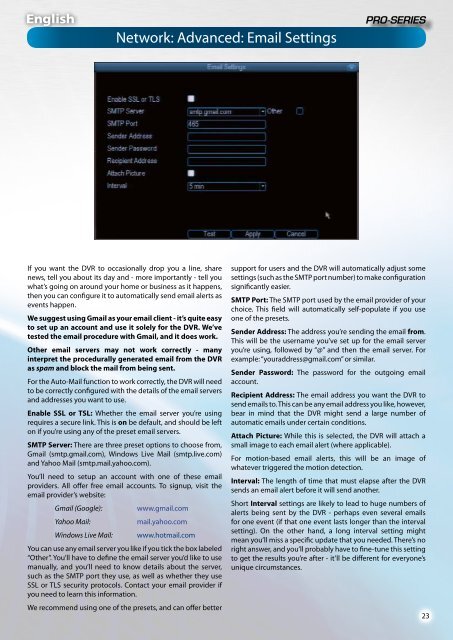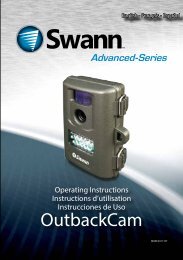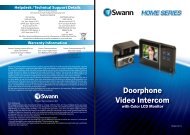4 / 8 Channel D1 Realtime H.264 DVR - Maplin Electronics
4 / 8 Channel D1 Realtime H.264 DVR - Maplin Electronics
4 / 8 Channel D1 Realtime H.264 DVR - Maplin Electronics
You also want an ePaper? Increase the reach of your titles
YUMPU automatically turns print PDFs into web optimized ePapers that Google loves.
English<br />
Network: Advanced: Email Settings<br />
If you want the <strong>DVR</strong> to occasionally drop you a line, share<br />
news, tell you about its day and - more importantly - tell you<br />
what’s going on around your home or business as it happens,<br />
then you can configure it to automatically send email alerts as<br />
events happen.<br />
We suggest using Gmail as your email client - it’s quite easy<br />
to set up an account and use it solely for the <strong>DVR</strong>. We’ve<br />
tested the email procedure with Gmail, and it does work.<br />
Other email servers may not work correctly - many<br />
interpret the procedurally generated email from the <strong>DVR</strong><br />
as spam and block the mail from being sent.<br />
For the Auto-Mail function to work correctly, the <strong>DVR</strong> will need<br />
to be correctly configured with the details of the email servers<br />
and addresses you want to use.<br />
Enable SSL or TSL: Whether the email server you’re using<br />
requires a secure link. This is on be default, and should be left<br />
on if you’re using any of the preset email servers.<br />
SMTP Server: There are three preset options to choose from,<br />
Gmail (smtp.gmail.com), Windows Live Mail (smtp.live.com)<br />
and Yahoo Mail (smtp.mail.yahoo.com).<br />
You’ll need to setup an account with one of these email<br />
providers. All offer free email accounts. To signup, visit the<br />
email provider’s website:<br />
Gmail (Google):<br />
www.gmail.com<br />
Yahoo Mail:<br />
mail.yahoo.com<br />
Windows Live Mail: www.hotmail.com<br />
You can use any email server you like if you tick the box labeled<br />
“Other”. You’ll have to define the email server you’d like to use<br />
manually, and you’ll need to know details about the server,<br />
such as the SMTP port they use, as well as whether they use<br />
SSL or TLS security protocols. Contact your email provider if<br />
you need to learn this information.<br />
We recommend using one of the presets, and can offer better<br />
support for users and the <strong>DVR</strong> will automatically adjust some<br />
settings (such as the SMTP port number) to make configuration<br />
significantly easier.<br />
SMTP Port: The SMTP port used by the email provider of your<br />
choice. This field will automatically self-populate if you use<br />
one of the presets.<br />
Sender Address: The address you’re sending the email from.<br />
This will be the username you’ve set up for the email server<br />
you’re using, followed by “@” and then the email server. For<br />
example: “youraddress@gmail.com” or similar.<br />
Sender Password: The password for the outgoing email<br />
account.<br />
Recipient Address: The email address you want the <strong>DVR</strong> to<br />
send emails to. This can be any email address you like, however,<br />
bear in mind that the <strong>DVR</strong> might send a large number of<br />
automatic emails under certain conditions.<br />
Attach Picture: While this is selected, the <strong>DVR</strong> will attach a<br />
small image to each email alert (where applicable).<br />
For motion-based email alerts, this will be an image of<br />
whatever triggered the motion detection.<br />
Interval: The length of time that must elapse after the <strong>DVR</strong><br />
sends an email alert before it will send another.<br />
Short Interval settings are likely to lead to huge numbers of<br />
alerts being sent by the <strong>DVR</strong> - perhaps even several emails<br />
for one event (if that one event lasts longer than the interval<br />
setting). On the other hand, a long interval setting might<br />
mean you’ll miss a specific update that you needed. There’s no<br />
right answer, and you’ll probably have to fine-tune this setting<br />
to get the results you’re after - it’ll be different for everyone’s<br />
unique circumstances.<br />
23















